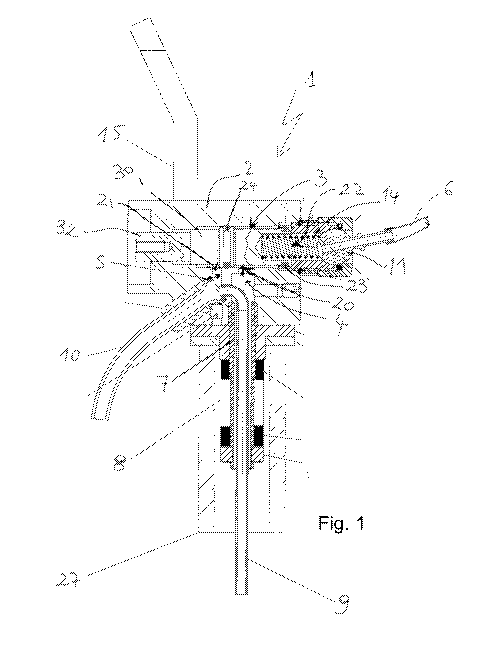Une partie des informations de ce site Web a été fournie par des sources externes. Le gouvernement du Canada n'assume aucune responsabilité concernant la précision, l'actualité ou la fiabilité des informations fournies par les sources externes. Les utilisateurs qui désirent employer cette information devraient consulter directement la source des informations. Le contenu fourni par les sources externes n'est pas assujetti aux exigences sur les langues officielles, la protection des renseignements personnels et l'accessibilité.
L'apparition de différences dans le texte et l'image des Revendications et de l'Abrégé dépend du moment auquel le document est publié. Les textes des Revendications et de l'Abrégé sont affichés :
| (12) Demande de brevet: | (11) CA 2848644 |
|---|---|
| (54) Titre français: | DISPOSITIF DE DISTRIBUTION POUR BOISSONS |
| (54) Titre anglais: | DISPENSING DEVICE FOR BEVERAGES |
| Statut: | Réputée abandonnée et au-delà du délai pour le rétablissement - en attente de la réponse à l’avis de communication rejetée |
| (51) Classification internationale des brevets (CIB): |
|
|---|---|
| (72) Inventeurs : |
|
| (73) Titulaires : |
|
| (71) Demandeurs : |
|
| (74) Agent: | NORTON ROSE FULBRIGHT CANADA LLP/S.E.N.C.R.L., S.R.L. |
| (74) Co-agent: | |
| (45) Délivré: | |
| (86) Date de dépôt PCT: | 2012-07-16 |
| (87) Mise à la disponibilité du public: | 2013-01-24 |
| Licence disponible: | S.O. |
| Cédé au domaine public: | S.O. |
| (25) Langue des documents déposés: | Anglais |
| Traité de coopération en matière de brevets (PCT): | Oui |
|---|---|
| (86) Numéro de la demande PCT: | PCT/IB2012/053622 |
| (87) Numéro de publication internationale PCT: | WO 2013011445 |
| (85) Entrée nationale: | 2014-03-13 |
| (30) Données de priorité de la demande: | ||||||
|---|---|---|---|---|---|---|
|
L'invention porte sur un dispositif (1) pour distribuer des liquides, en particulier du vin, à partir d'une bouteille ou d'un récipient similaire, lequel dispositif comprend un corps (2) conçu pour fonctionner avec le col (27) de la bouteille et pour provoquer la fuite du liquide à partir d'un tuyau de soufflage (10) résultant de la fourniture dans la bouteille d'un gaz inerte (par exemple de l'azote) sous pression. Ledit corps (2) comprend un premier conduit (3), disposé transversalement et avec une première ouverture (22) pour la fourniture du gaz. Deux autres ouvertures (20 et 21) sont disposées le long du conduit (3) pour relier celles-ci à un second conduit (4) conçu pour fournir le gaz à l'intérieur de la bouteille, et, respectivement, à un troisième conduit (5) comportant un tuyau de soufflage (10) pour distribuer le liquide.
A device (1) for dispensing liquids, particularly wine, from a bottle or similar container includes a body (2) designed to work with the neck (27) of the bottle and to cause the leakage of the liquid from a blowpipe (10) resulting from the supply in the bottle of an inert gas (eg. nitrogen) under pressure. Said body (2) comprises a first conduit (3), placed transversely and with a first opening (22) for the supply of the gas. Two further openings (20 and 21) are placed along the conduit (3) for connecting them with a second conduit (4) designed to supply the gas inside the bottle and, respectively, with a third conduit (5 ) provided with a blowpipe (10) for dispensing the liquid.
Note : Les revendications sont présentées dans la langue officielle dans laquelle elles ont été soumises.
Note : Les descriptions sont présentées dans la langue officielle dans laquelle elles ont été soumises.

2024-08-01 : Dans le cadre de la transition vers les Brevets de nouvelle génération (BNG), la base de données sur les brevets canadiens (BDBC) contient désormais un Historique d'événement plus détaillé, qui reproduit le Journal des événements de notre nouvelle solution interne.
Veuillez noter que les événements débutant par « Inactive : » se réfèrent à des événements qui ne sont plus utilisés dans notre nouvelle solution interne.
Pour une meilleure compréhension de l'état de la demande ou brevet qui figure sur cette page, la rubrique Mise en garde , et les descriptions de Brevet , Historique d'événement , Taxes périodiques et Historique des paiements devraient être consultées.
| Description | Date |
|---|---|
| Demande non rétablie avant l'échéance | 2016-07-18 |
| Le délai pour l'annulation est expiré | 2016-07-18 |
| Réputée abandonnée - omission de répondre à un avis sur les taxes pour le maintien en état | 2015-07-16 |
| Inactive : Page couverture publiée | 2014-04-29 |
| Inactive : Notice - Entrée phase nat. - Pas de RE | 2014-04-17 |
| Inactive : CIB attribuée | 2014-04-15 |
| Inactive : CIB en 1re position | 2014-04-15 |
| Demande reçue - PCT | 2014-04-15 |
| Exigences pour l'entrée dans la phase nationale - jugée conforme | 2014-03-13 |
| Demande publiée (accessible au public) | 2013-01-24 |
| Date d'abandonnement | Raison | Date de rétablissement |
|---|---|---|
| 2015-07-16 |
Le dernier paiement a été reçu le 2014-07-10
Avis : Si le paiement en totalité n'a pas été reçu au plus tard à la date indiquée, une taxe supplémentaire peut être imposée, soit une des taxes suivantes :
Veuillez vous référer à la page web des taxes sur les brevets de l'OPIC pour voir tous les montants actuels des taxes.
| Type de taxes | Anniversaire | Échéance | Date payée |
|---|---|---|---|
| Taxe nationale de base - générale | 2014-03-13 | ||
| Rétablissement (phase nationale) | 2014-03-13 | ||
| TM (demande, 2e anniv.) - générale | 02 | 2014-07-16 | 2014-07-10 |
Les titulaires actuels et antérieures au dossier sont affichés en ordre alphabétique.
| Titulaires actuels au dossier |
|---|
| FRANCESCA BARNINI |
| Titulaires antérieures au dossier |
|---|
| S.O. |